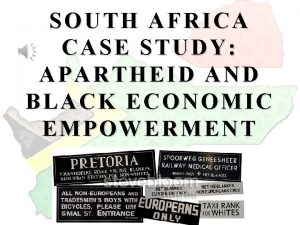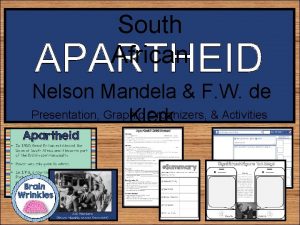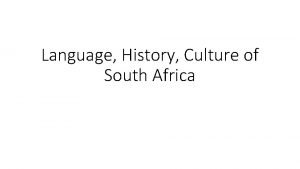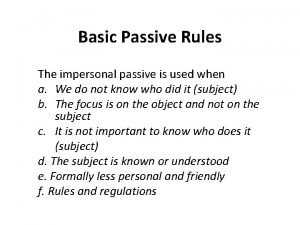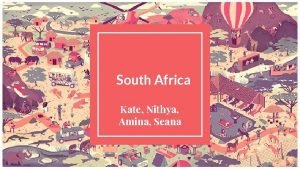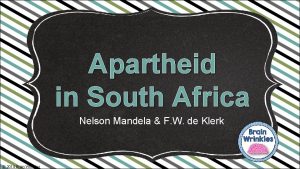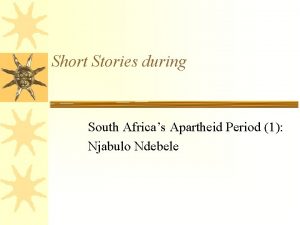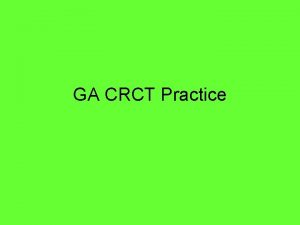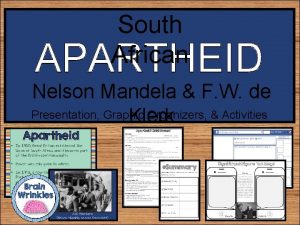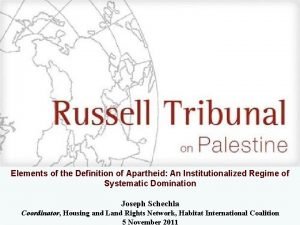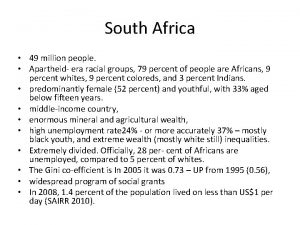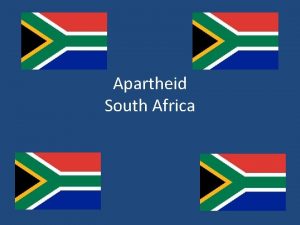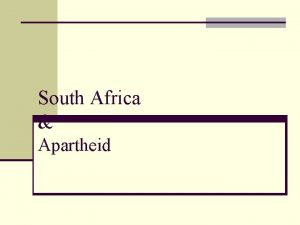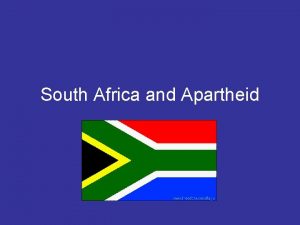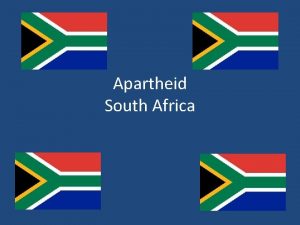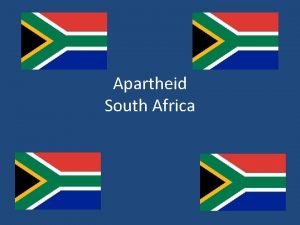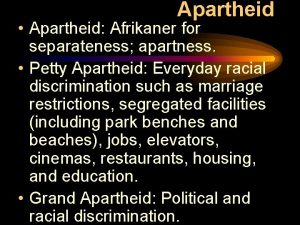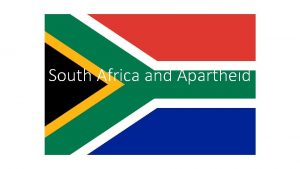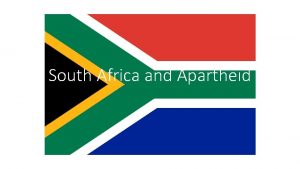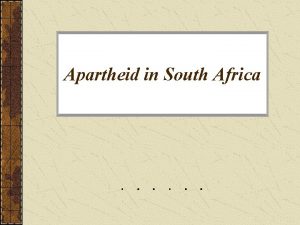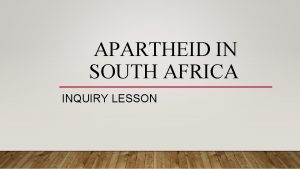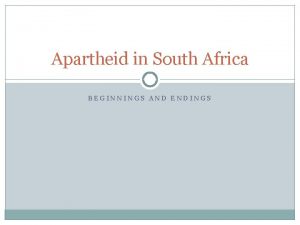South Africa 49 million people Apartheid era racial













- Slides: 13

South Africa • 49 million people. • Apartheid- era racial groups, 79 percent of people are Africans, 9 percent whites, 9 percent coloreds, and 3 percent Indians. • predominantly female (52 percent) and youthful, with 33% aged below fifteen years. • middle-income country, • enormous mineral and agricultural wealth, • high unemployment rate 24% - or more accurately 37% – mostly black youth, and extreme wealth (mostly white still) inequalities. • Extremely divided. Officially, 28 per- cent of Africans are unemployed, compared to 5 percent of whites. • The Gini co-efficient is In 2005 it was 0. 73 – UP from 1995 (0. 56), • widespread program of social grants • In 2008, 1. 4 percent of the population lived on less than US$1 per day (SAIRR 2010).

20 years democracy • Most progressive Constitution in the world • IN reality – Bill of Rights not achieved – – Implementation weak – weakened by political interference in staturoy bodies to protect human rights in SA • Gender rights in public space – limited in domestic • Highest GBV and male-Male violence of all countries not at war • NO equal access to education, health care • Housing – increased but still shortages • Big rural-urban divide

• Health – 10% HIV + = over 5 million – History of health rights struggles: – HIV treatment – strong movement built • Economic Policy – neo-liberal – – Overtaken by Nigeria as richest in Africa – Strong imperialist capitalist tendencies – Strong infrastructure but many problems (roads, rail) • Agriculture – – White Afrikaans dominated – Human rights violations – Low wages, evictions, farm worker security limited

• Poverty – Rural poverty – in some provinces – 2 supported by FO – N. Cape and E. Cape – Poor often invisible

• Mining – Massive natural resources – Migrant labour – Low wages – high profits – Strong unionised movements – Conflict between union s corruption and co-option among unions – Land raped, plundered, deserted – communities too – Social disintegration due to mining – migrant labour

Governance and corruption • Built into miracle of peaceful transition • Mandela – new hope and integrity • Mbeki era – arrogance and closing down debate and civil society co-option • Zuma era – disintegration of social values fabric – corruption systemic – feeds income inequalities and poverty, gender violence, ‘tribalism’, xenophobia, etc

Gender • Still massive inequalities, though numbers look good! • Extremely violent – even though strong revision of legislation to protect women – eg redefining rape, etc) • Strong lobbies – ANC, Civil society • Gender – women and men – • Not transformative – raise awareness and improve lives of women - same status • Local level – key challenges (traditional Leaders Bill – challenged and under revision)

• History of Struggle – Strong advocacy component in FO programme – Balanced with food security also • Rural poor – Urban poverty – (No support system; endemic violence) – Mining sector – July annually – ‘strike season’ – Withdrawal of foreign investors to countries where less empowered labour and lower wages – higheer profits – High levels of corruption in Government – media activism and exposure (less in business- but increasing)

Country Programme • Variation of partners – mixed competence and capacity – high level (yesterday) and more rural, community based (learning exchanges) • Two regional networks • Food Security and sovereignty - Mixed – some food security – agro-ecology, etc – Others also strong advocacy component – Link to mining – New issues – cattle impounding, blurring between private and communal land

Country Programme • Faith and Justice – Dioceses- low capacity – authoritarian, catechismcapacity building (country Coordination) – Ecumenical – less successful – Education – Theological educaiotn – strong Faith and Justice component

Challenges and plans for future (Baseline and MTR) • Reviewing Food Security / sovereignty– – Producers, consumers and workers – Stronger integration FS and obstacles (advocacy) – • Land, water, natural resources and extractives – Ideological foundation (subsistence vs productive and sustainable local economies + link to HR and Justice ) • Clarity re Faith and Justice – Also link between F and J – and Religion and Culture, given centrality of faith in Africa • Integration – F and J and FS • FO small donor for some orgs – – link FO programme and org programmes at times in reporting

Challenges • Strategic guidelines: – Too many? – Climate change – working on integrating better – Gender – • Is everybody’s issue – the fundamental form of injustice – underlies all other injustice and is the single most endemic obstacle to meaningful development • not just quantitative disaggregation – but also • Need for stronger interrogation re programme impacts and design (who sets the agenda? ) – Addressing Gender as 3 rd most NB request for capacity building amongst partners (starting with N Cape)

Challenges • M and E: – Searching for qualitative and process indicators – to interrogate the quantitative data • For improvement of programme, integration, sharing of learnings, etc • Identifying trends and celebrating progress – energising! – Need for M and E methods that are comprehensible by communities so they can integrate them also for their own growth and effectiveness
